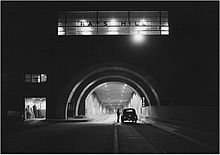Rays Hill Tunnel

Rays Hill Tunnel at night in 1942
|
|
| Overview | |
|---|---|
| Line | South Penn abandoned |
| Location |
Rays Hill, Bedford / Fulton counties, Pennsylvania, USA |
| Coordinates | 40°01′05″N 78°12′14″W / 40.01806°N 78.20389°WCoordinates: 40°01′05″N 78°12′14″W / 40.01806°N 78.20389°W |
| Status |
Abandoned Pennsylvania Turnpike Currently Pike2Bike Trail |
| Operation | |
| Work begun | 1881 - railway 1938 - highway |
| Constructed | 1881–1885 - railway 1938–1940 - highway |
| Opened | October 1, 1940 |
| Closed | November 26, 1968 - Interstate 76 |
| Owner | South Pennsylvania Railroad abandoned Pennsylvania Turnpike Commission abandoned Pike2Bike Trail |
| Character | Hiking, biking, and skateboard trail |
| Technical | |
| Length | 2,532 feet (772 m) - highway |
| No. of lanes | 2 |
Rays Hill Tunnel is one of three original Pennsylvania Turnpike tunnels which were abandoned (this one in 1968) after two massive realignment projects. The others included the Sideling Hill Tunnel, and farther west, the Laurel Hill Tunnel.
Rays Hill Tunnel is 3,532 feet (1,077 m) long. It was the shortest of the seven original tunnels on Pennsylvania Turnpike. Due to its short length, it only contains ventilation fans at its western portal. Its eastern portal is the only one of the 14 tunnel portals on the original turnpike that has no ventilation fan housing. It can be seen by westbound traffic on the Turnpike.
The tunnel connects Bedford and Fulton Counties in South Central Pennsylvania.
From the Turnpike's opening in 1940 until the realignment projects, the tunnels were bottlenecks due to reduced speeds with opposing traffic in the same tubes.
Studies were completed for the remaining five mainline tunnels to determine the cost benefit of twinning of the tunnels, or complete bypass. After the studies completed, the decision was made to go ahead with a US $100 million construction project to work with the tunnels. Construction began on September 6, 1962, with the first subproject being a bypass of the Laurel Hill Tunnel. On October 30, 1964, just two years after construction began, the Laurel Hill Bypass was completed and opened. The Laurel Hill Tunnel was permanently closed on that day. However, this was not the last bypass to occur for tunnels along the turnpike. Two years after the closing of the Laurel Hill, the Allegheny Mountain became the first tunnel to be twinned, and opened on August 25, 1966. With the twinning of the Blue Mountain, Kittatinny Mountain and Tuscarora Mountain tunnels under construction, the Commission turned its focus to the remaining two mainline tunnels, the Rays Hill Tunnel (the shortest tunnel) and the Sideling Hill Tunnel (the longest tunnel).
An engineering report dating back to 1961 suggested that building a bypass around the last two mainline tunnels was the best way to solve the congestion. The Commission awarded three contracts to construct the bypass from July 1966 to March 1967. The contracts cost $17.2 million for roadway and another $2.5 million for construction of a new Sideling Hill Service Plaza to replace the Cove Valley Service Plaza, which was along the to-be-bypassed alignment. The $2.5 million project was to include ramps from both directions to the service plaza, so it could serve both directions. The style of the tunnel bypass was to follow the same style as the Laurel Hill bypass. On November 26, 1968, the three twinned tunnels opened, and the bypass of the Rays Hill and Sideling Hill Tunnels opened. The new bypass also opened the Breezewood Interchange and the number of lanes along the turnpike expanded to four (two in each direction) or five (two in each direction, plus a climbing lane going uphill).
...
Wikipedia
